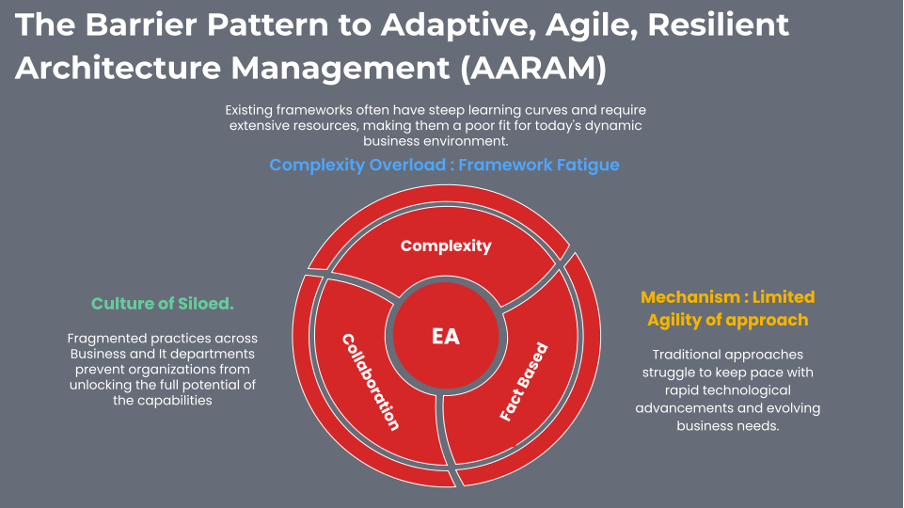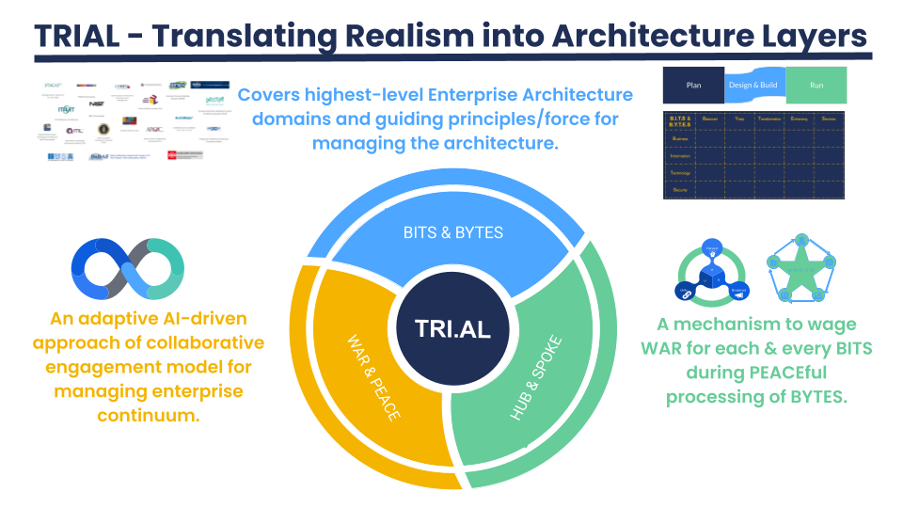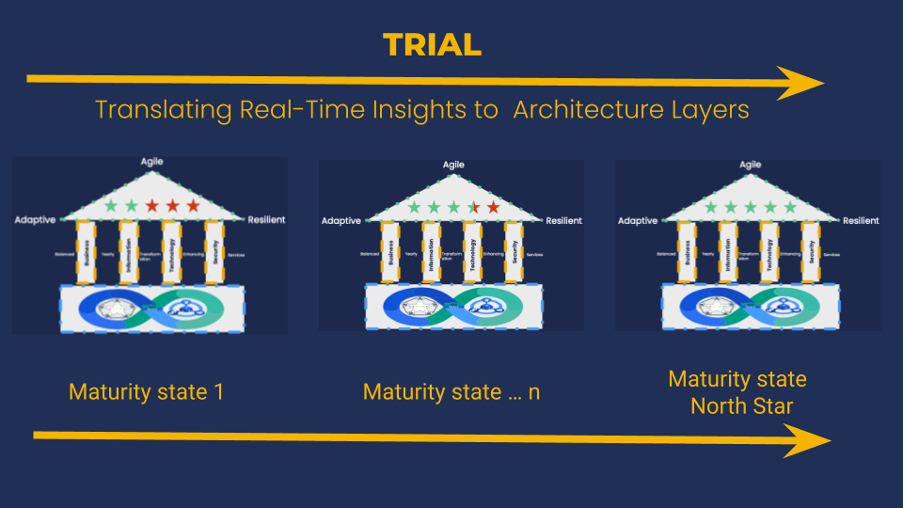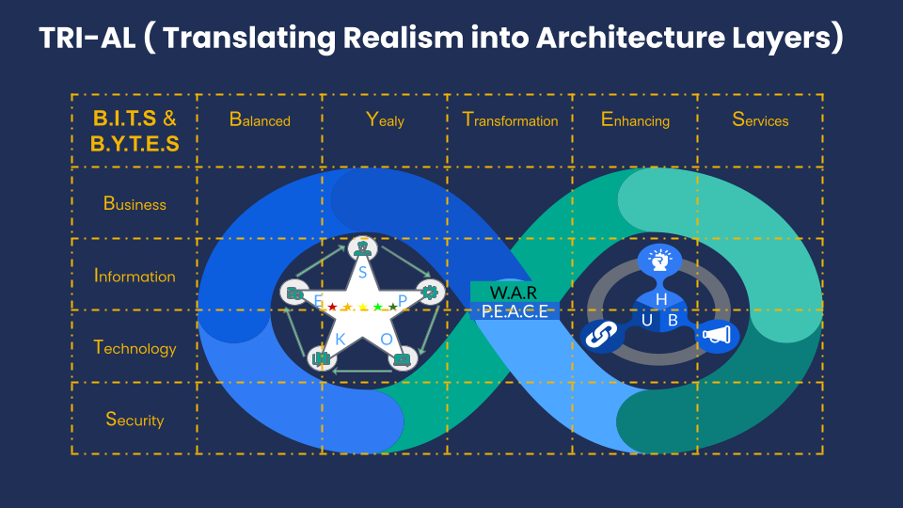
(Editor’s Note: This article represents part four of an ongoing series. Part one, appeared on August 18, entitled “The Unavoidable ‘SCREAM’: Why Enterprise Architecture Must Transform for the Organization of Tomorrow“, introduced the conceptual overview. Part two, “The Anatomy of SCREAM: A Perfect Storm in EA Cupboard” detailed the current state of chaotic SCREAM. Part three, “The Co-Architect EA: Enterprise AARAM Through AI” detailed the aspirational future state of blissful AARAM. This installment introduces TRIAL—the practice that bridges the gap between SCREAM and AARAM.)
Despite billions invested annually in enterprise architecture (EA), organizations grapple with a persistent gap between theoretical frameworks and practical execution. In 2025, 94% of CIOs deem EA “absolutely critical” for embedding sustainability and driving digital resilience, yet 57% of architects report feeling underutilized in strategic initiatives. Compounding this, 60% find existing tools inadequate for delivering the speed, flexibility, and visibility demanded by business leaders—primarily due to siloed, outdated data.
Recent surveys underscore these execution hurdles: 80-85% of EA initiatives fall short of expectations, often from poor business alignment, fragmented collaboration, and limited executive buy-in. Alarmingly, only 16% of enterprises achieve consistent, measurable ROI from their EA practices, even as the global EA software market surges to $507.2 million in 2025 with a 9.6% CAGR through 2032. Traditional frameworks like TOGAF—adopted by over 80% of Fortune 500 firms—remain globally dominant but face scrutiny for rigidity in agile and AI-driven environments. As one expert notes, “In 2025, architecture is no longer about diagrams; it’s about capital protection, compliance, and survival.”
Understanding the Three-Barrier Pattern
The enterprise architecture landscape is ensnared in a persistent TRIAD of barriers that prevents organizations from achieving their architectural objectives:
1. Complexity Overload
EA often starts with good intentions but gets bogged down by excessive compliance checks, opaque models, and inflexible frameworks. The focus shifts from solving problems to satisfying documentation requirements, leading to architect burnout and a perception that EA is primarily bureaucratic overhead.
2. Siloed Value
Architecture efforts become isolated, failing to deliver tangible business outcomes. When architects produce artifacts that don’t directly map to strategic priorities, the EA function becomes an ivory tower—understood only by its own members and seen as a drain on resources by business leaders.
3. Agility Deficit
Many EA practices still operate on long-cycle planning and heavyweight documentation while business operates at DevOps speed. This sluggish mechanism renders architecture efforts irrelevant in the face of fast-moving business and technology changes.

A Simpler Path Forward with TRIAL
To dismantle these barriers, we propose TRIAL—Translating Real-Time Insights to Architecture Layers—a simplified, AI/data-driven architecture practice management approach that bridges SCREAM (the chaotic present) and AARAM (the adaptive future).
TRIAL uses “Plan, Design & Build, Run” as key engagement motifs for managing lifecycle changes across architecture domains, but with a crucial difference: it starts with your existing data and stakeholder relationships rather than abstract models.

At its core, architecture is about effectively managing the lifecycle changes of architecture components and their relationships. TRIAL establishes an EA approach that resonates with architects and stakeholders by embracing these lifecycle stages as central motifs. This approach captures and builds a data and AI-driven architecture around its underlying evolving repository continuum, leveraging the same engagement model for collaborative execution aligned with organizational objectives.
Why TRIAL? The Power of Three
The TRIAL structure isn’t arbitrary—it reflects deep philosophical and practical wisdom. From Auguste Comte’s Law of Three Stages (theological, metaphysical, scientific) to Charles Peirce’s logic positing that the triad is the atom of all social and relational life, the pattern of three has proven essential to understanding complex systems. EA must perform this trial—this systematic examination through three lenses—to capture the realism of enterprise architecture.
The TRIAL Framework Core
TRIAL centers on three interconnected elements that create sustainable architecture practice:
BITS & BYTES encompasses the foundational domains—Business, Information, Technology, and Security—serving as the architectural management foundation. These areas align with phased progressions from Balanced Strategy to Yearly Plan to Transformation to Enhancing to Services. Rather than abstract modeling, this focuses on discovering and connecting actual data relationships across domains, revealing natural patterns and dependencies.
WAR & PEACE represents the central pivot strategy that drives collaboration and resolution across the enterprise continuum. This balanced approach isn’t not only about conflict, but about finding practical solutions that satisfy multiple stakeholder perspectives while maintaining architectural integrity.
HUB & SPOKE provides the distribution mechanism to deploy efforts effectively, ensuring every component thrives within the system. This model enables both centralized governance and distributed execution, critical for modern organizations.

Progressive Maturity Through TRIAL
Enterprise architecture maturity traditionally requires skilled resources, extensive knowledge, and significant time investment. Organizations face resource scarcity while architects average only 18-24 months tenure, making adaptive architecture management nearly impossible. This challenge is exacerbated by broader technology trends, where 70-85% of enterprise AI projects fail due to poor data management, misalignment with business goals, and architectural oversights—rates double those of non-AI IT projects.
TRIAL addresses this through progressive maturity states that build upon each other. Organizations advance through clearly defined maturity levels—from Balanced (foundation) through Yearly (planning), Transformation (change), Enhancing (optimization), to Services (delivery)—with each state representing measurable improvements in architectural capability, stakeholder engagement, and business value delivery.

The accompanying grid outlines this journey through stages, offering a roadmap for organizations to follow. Each element holds deeper insights that we’ll explore in upcoming articles dedicated to unlocking TRIAL’s full potential.
TRIAL as an Adoption Gateway
TRIAL doesn’t replace existing EA frameworks—it creates an adoption pathway that addresses current limitations:
Simplicity and Speed: Designed for faster adoption within complex organizations while maintaining architectural rigor.
Collaborative Practice: Emphasizes cross-departmental collaboration to leverage diverse perspectives and break down silos.
Incremental Maturity: Enables organizations to achieve architecture maturity progressively, leveraging various techniques and artifacts.
Practical Application: Aligns architecture with real-world needs, ensuring a “rubber meets the road” approach that maps directly to business outcomes.
Framework Integration: TRIAL serves as a coordination layer for existing frameworks—TOGAF for architecture development, NIST for security, ITIL for service management, BABOK for business analysis—orchestrating them toward unified organizational objectives.
AI-Powered Future
TRIAL lays the foundation for future-proof architecture practice. As AI technology matures, it seamlessly integrates advanced capabilities into the framework:
AI-powered Enterprise Continuum: Automated discovery of data patterns and underlying relationships, accelerating the shift from manual documentation to intelligent insights.
Intelligent Automation: Automated data and relationship mapping, diagram generation, and visual representation of complex architectures.
Enhanced EA Functions: AI-assisted standards management, roadmapping, scenario planning, and financial optimization such as cloud spend analysis.
Tools like digital twins and automated roadmapping align tech investments to business priorities in real time, paving the way toward AARAM (Adaptive, Agile, Resilient Architecture Management), where EA adapts seamlessly to 2025’s demands.
From SCREAM to AARAM

The proposed TRIAL path is comprehensive, covering key aspects of enterprise architecture: domain-specific considerations, organizational agility, measurable outcomes, adaptive execution, and alignment with core architecture functions. Its strength lies in promoting collaboration, stakeholder engagement, and tailoring the approach based on use cases and organizational maturity level.
By adopting TRIAL, organizations can progressively mature their Enterprise Architecture practices, enhance stakeholder engagement, optimize resource utilization, and achieve improved business-technology alignment, agility, and competitive advantage. The approach unlocks the full potential of EA capabilities, fostering innovation and efficiency while facilitating truly synchronized and adaptable architecture in an ever-evolving business landscape.
TRIAL transforms enterprise architecture from a theoretical exercise trapped in SCREAM into a practical, value-driven discipline achieving AARAM—where architecture adapts, anticipates, and accelerates business success.
References
[0] Orbus Software: Enterprise Architecture and Digital Transformation Trends for 2025
[1] Orbus Software: 2025 Research Findings
[2] Coherent Market Insights: Enterprise Architecture Software Market Forecast, 2025-2032
[4] Forbes: Why Enterprise Architecture Is Having a Moment (2025)
[5] LinkedIn: Is TOGAF Relevant in 2025?
[6] Intelance: What Is Enterprise Architecture in 2025?
[7] LinkedIn: The Evolving Landscape of Enterprise Architecture in 2025
